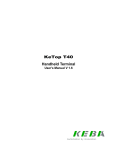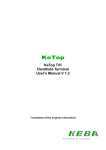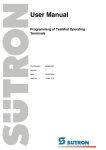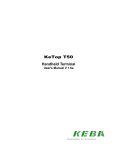Download 3 Programming the Handheld Terminal
Transcript
KeTop T40 Handheld Terminal Serial Gateway Coupling User’s Manual V 1.1 Notes on This Manual At various points in this manual you will see notes and precautionary warnings regarding possible hazards. The meaning of the symbols used is explained below. ! DANGER z DANGER indicates an imminently hazardous situation which, if not avoided, will result in death or serious injury. ! WARNING z WARNING indicates a potentially hazardous situation which, if not avoided, could result in death or serious injury. ! CAUTION z CAUTION indicates a potentially hazardous situation which, if not avoided, may result in minor or moderate injury. CAUTION z CAUTION used without the safety alert symbol indicates a potentially hazardous situation which, if not avoided, may result in property injury. This symbol reminds you of the possible consequences of touching electrostatically sensitive components. Note Notes on use of equipment and useful practical tips are identified by the “Notice” symbol. Notices do not contain any information that draws attention to potentially dangerous or harmful functions. © KEBA 2005 Specifications are subject to change due to further technical developments. Details presented may be subject to correction. All rights reserved. Document: version 1.1 / material no.: 62010 Filename: t40_gateway_en.doc, last saving on: 9. 12. 2004 KEBA AG, Postfach 111, Gewerbepark Urfahr, A-4041 Linz Tel.: ++43 / 732 / 70 90-0, Fax: ++43 / 732 / 73 09 10, E-Mail: [email protected], www.keba.com KEBA GmbH, Ulmer Straße 123, D-73037 Göppingen Tel.: ++49 / 7161 / 97 41-0*, Fax: ++49 / 7161 / 97 41-40 KEBA Corp., 100 West Big Beaver Road, Troy, MI 48084 Tel. ++1 / 248 / 526 - 0561, Fax: ++1 / 248 / 526 - 0562, E-Mail: [email protected] Handheld Terminal Contents History Modification from / to V1.0 V1.0/V1.1 Date 8-2002 12-2004 Modified pages all User's Manual, version: 1.1 / material no.: 62010 © KEBA 2005 Description Author First release New Layout sam sam 3 Contents 4 KeTop T40 User's Manual, version: 1.1 / material no.: 62010 © KEBA 2005 Handheld Terminal Contents Contents 1 Introduction.....................................................................................................................................7 2 Connection ......................................................................................................................................8 3 Programming the Handheld Terminal ..........................................................................................9 Programming Software .............................................................................................................9 Configuration.............................................................................................................................9 4 HT Power-Up Phase after Turning On ........................................................................................10 5 Protocol .........................................................................................................................................11 MMI-COM................................................................................................................................11 Overview of Functions ............................................................................................................18 Serial Side (KeTop -> Gateway) .............................................................................................21 Structure of Telegrams ...........................................................................................................21 Bus Side (Gateway <-> SPS) .................................................................................................24 6 HT System Variables ....................................................................................................................25 7 HT Functions.................................................................................................................................27 Keypad ....................................................................................................................................27 LEDs .......................................................................................................................................35 Texts .......................................................................................................................................42 Text Monitor ............................................................................................................................53 PLC activates Signal Buzzer on KeTop T40...........................................................................55 Menu Access/Exit ...................................................................................................................56 System Reset..........................................................................................................................56 Graphic Functions...................................................................................................................57 User's Manual, version: 1.1 / material no.: 62010 © KEBA 2005 5 Serial Gateway Coupling Introduction 1 Introduction This document is a supplement to the User's Manual "KeTop T40 Handheld Terminal - General Information" and describes the serial gateway protocol. For a detailed description of the programming, the special functions and the key labelling of the HT, please refer to the User's Manual "KeTop T40 Handheld Terminal - General Information". User's Manual, version: 1.1 / material no.: 62010 © KEBA 2005 7 Connection KeTop T40 2 Connection The serial gateway box can be connected to the handheld terminal via the serial interface COM2. By means of DIP switches, this interface must be configured as: COM2: RS-422-A See also User's Manual "KeTop T40 Handheld Terminal - General Information", chapter "Connection". KETOP T40 KETOP RS-422-A KETOP CB320 for KETOP CB233 for KETOP CB234 for KETOP CB235 for KETOP CB236 for MPI PROFIBUS-DP InterBus DeviceNet CAN oder CANopen CP 450/C DIAG 0 4 RX DEBUG TX PCI2 PCI0 RX 450/A RX 450/A SI1 COMPACT FLASH SI0 CT RL RS 450/A S TA TU S 12 8 SI1 1 PLC USB1 BATTE RY PCI3 PCI1 RX 450/A RX 450/A SIM 1 SIM 0 K-CAN ETHERNET USB0 9 Connection of HT via gateway box 8 User's Manual, version: 1.1 / material no.: 62010 © KEBA 2005 Serial Gateway Coupling Programming the Handheld Terminal 3 Programming the Handheld Terminal Programming Software For setting the device configuration and creating texts, we deliver a programming software which is executable under Windows. The programming of the handheld terminal is described in detail (e.g. functions for editing the keypad assignment and for loading the program) in the User's Manual "KeTop T40 Handheld Terminal - General Information" and applies in general also to the serial gateway coupling. Therefore the following chapter only describes the specific details of the gateway coupling. Configuration Selection of protocol After selection of the protocol „Seriell Gateway MMI-COM“ the following parameters must be set: Interface Selection of required interface. Baudrate Selection of baud rate required for transmission: 9600, 19200, 38400, 57600, 115200 Baud. Parity The setting of priority is NO and cannot be changed. Data bit The number of data bits is 8 and cannot be changed. Stop bit The number of stop bits is 1 and cannot be changed. Numbering of variables For the serial use of the HT the following restriction must be taken into account in the text editing mode: User variables may be defined only from variable number 100 on. The range from 1 to 99 is reserved for the system variables (see also chapter "HT System Variables"). EXCEPTION: string variables (numbering from 0 to 255) User's Manual, version: 1.1 / material no.: 62010 © KEBA 2005 9 HT Power-Up Phase after Turning On KeTop T40 4 HT Power-Up Phase after Turning On The handheld terminal carries out a self-test after turning on. For details on the test steps, refer to the User's Manual "KeTop T40 Handheld Terminal General Information". ► The first part of the test is identical for all KeTop T40 couplings and therefore described in the User's Manual "KeTop T40 Handheld Terminal - General Information". ► Then the configuration data are loaded. The following message is displayed: Serial Gateway Vx.x Initializing... In case of an error, the handheld terminal remains in this condition. ► After the configuration data have been loaded successfully, the following mask appears on the display: Serial Gateway Vx.x Profile: MMI-COM Channel: COMn, mmmmm ooooo,NO,8,1 x n m o program version number of interface port type of interface ( RS232 or RSxx2 for RS232/RS422) baud rate (9600, 19200, 38400, 57600, 115200 Baud) ► After approx. 1 second, the display indicates: Serial Gateway Vx.x Wait for gateway connection After successful establishment of the communication with the gateway box and after successful loading of the serial configuration data, the interface parameters will be displayed again. This message remains displayed until it is overwritten by a text activated by the PLC. 10 User's Manual, version: 1.1 / material no.: 62010 © KEBA 2005 Serial Gateway Coupling Protocol 5 Protocol The coding of the telegrams is based on the MMI-COM profile which was specified for operating and display panels used on the INTERBUS. MMI-COM MMI-COM signifies „Man Machine Interface-Communication“. This profile definition standardizes the communication so that every station interprets the data in the same way. Functions standardize some essential parameters of an MMI device. The communication model of MMI-COM is based on the fact that data are sent to objects or by objects. The objects are addressed with a number (index). In general, the connection with the index specifies how the data are to be interpreted. The bitmap 01000001 can for example stand for the binarycoded number 65, for the BIT-coded number 41, for the ASCII character A, for two keys pressed simultaneously or for the request to turn on the buzzer. Handshaking The header consists of the following 16 bits: Fault Handshake receiving Handshake sending Standard Index Reserved Reserved Bit No. On-line Header 7 6 5 4 3 2 1 0 Byte 1 Index 7 6 5 4 3 2 1 0 Byte 2 The first header byte contains the handshake information for both applications. The second header byte contains the index and describes the contents of the subsequent data part. The following description of the bits of byte 1 refers to both the PLC and the KeTop T40. Therefore device may be the PLC or the KeTop T40 depending on the direction. User's Manual, version: 1.1 / material no.: 62010 © KEBA 2005 11 Protocol KeTop T40 On-line (bit 7) This bit indicates that the device is ready for receiving. If the device is not on-line, no messages should be sent to the device. Irrespective of that, the device may send data. The on-line bit and the fault bit do not depend on each other. Fault (bit 6) This bit indicates a fault on the device. If the device is on-line a fault code can be requested. Handshake receiving (bit 5) This bit is set after a message is received. With each message received, the state of this bit changes: When the first message is received, the state changes from 0 to 1. When the next message is received, the state changes from 1 to 0 again. Handshake sending (bit 4) This bit signalizes the sending of a new message. With each message sent, the status of this bit changes: When the first message is sent, the state changes from 0 to 1. When the next message is sent, the state changes from 1 to 0 again. Standard bit (bit 3) This bit defines the assignment of the data field for the process data transmission. In this case, the significance of the PD index is standardized. If this bit is not set, that means that the significance of the field is manufacturer-specific. Index bit (bit 2) This bit defines the existence of an index field in the byte 2 of the header byte. Therefore it is always set to 1. The following diagram shows an example of handshaking in the MMICOM protocol between PLC and KeTop T40. 12 User's Manual, version: 1.1 / material no.: 62010 © KEBA 2005 Serial Gateway Coupling The PLC is the client and sends the 2nd message. The state of the send bit changes (1 -> 0). The PLC is the server and confirms the message by changing the state of its receive bit (0 -> 1). At the same time the PLC is the client again and sends a message. The state of the send bit changes (0 -> 1). The PLC is the server and confirms the message by changing the state of its receive bit (1 -> 0). On-line Fault Receiving Sending Standard Index The PLC is the client and sends the 1st message. The state of the send bit changes (0 -> 1). 1 0 0 0 1 1 x x 1 0 0 0 1 1 x x Situation 1 0 1 0 1 1 x x Confirm (Server) 1 0 0 0 1 1 x x Confirm (Server) 1 0 0 1 1 1 x x Sending (Client) 1 0 1 1 1 1 x x Confirm (Server) 1 0 1 0 1 1 x x Sending (Client) Situation Sending (Client) 1 0 0 1 1 1 x x Sending (Client) Sending (Client) Confirm (Server) KETOP T40 On-line Fault Receiving Sending Standard Index SPS Protocol The KETOP T40 is the server and confirms the message by changing the state of its receive bit (0 -> 1). 1 0 0 0 1 1 x x The KETOP T40 is still the server and confirms the next message again by changing its receive bit (1 -> 0). The KETOP T40 is the client and sends a message. The state of its send bit changes (0 -> 1). 1 0 1 1 1 1 x x The KETOP T40 is the server again and confirms the message by changing the state of its receive bit (0 -> 1). The KETOP T40 is the client and sends a message. The state of its send bit changes (1 -> 0). 1 0 0 1 1 1 x x Handshaking between PLC and KeTop T40 User's Manual, version: 1.1 / material no.: 62010 © KEBA 2005 13 Protocol KeTop T40 a) Receiving Data MMICOM Receive Read IN-Data ONLINE_BIT (IN) == 1 & DISTURBANCE_BIT (IN) == 0 ? N Y SEND_BIT (IN) <> RECV_BIT (OUT) ? N Y RECV_BIT (OUT) = SEND_BIT (IN) ONLINE_BIT (OUT) = 1 DISTURBANCE_BIT (OUT) = 0 Write OUT-Data INDEX_BIT (IN) == 1 ? N Y Analyze Index & Execute Order Error Handling END Handshaking when receiving data 14 User's Manual, version: 1.1 / material no.: 62010 © KEBA 2005 Serial Gateway Coupling Protocol b) Sending Data The KeTop T40 tests if the receive bit of the partner station has the same state as the own send bit. If this is the case the device will be able to send data. The corresponding data and the index will be copied to the output buffer. Notice To avoid inconsistent data in the message at bus systems with cyclic data transfer (e.g. PROFIBUS, InterBus), the first header byte containing the toggled send bit must always be written as last byte. Following that the send bit of the send station will be inverted to indicate the sending. The handshake of the partner statioin is monitored. If the counterpart station does not respond within 1 s, the send bit will be toggled. User's Manual, version: 1.1 / material no.: 62010 © KEBA 2005 15 Protocol KeTop T40 MMICOM Send Read IN-Data ONLINE_BIT (IN) == 1 ? N Y SEND_BIT (IN) == RECV_BIT (OUT) ? N MMICOM Receive Y N Timeout ? RECV_BIT (IN) == SEND_BIT (OUT) ? Y N Y SEND_BIT (OUT) == 0 ? N Y SEND_BIT (OUT) = 1 A 16 SEND_BIT (OUT) = 0 Error Handling B User's Manual, version: 1.1 / material no.: 62010 © KEBA 2005 Serial Gateway Coupling Protocol B A ONLINE_BIT (OUT) = 1 DISTURBANCE_BIT (OUT) = 0 INDEX_BIT (OUT) = 1 STANDARD_BIT (OUT) = 1 / 0 Copy Index & Data Write OUT-Data N Read IN-Data Timeout 1 sec ? RECV_BIT (IN) == SEND_BIT (OUT) ? Y N SEND_BIT (OUT) == 0 ? N Y Y SEND_BIT (OUT) = 1 SEND_BIT (OUT) = 0 Write OUT-Data END Handshaking when sending data User's Manual, version: 1.1 / material no.: 62010 © KEBA 2005 17 Protocol KeTop T40 Overview of Functions The following table shows an overview of the services that constitute the base of the particular handheld terminal functions. Services are request telegrams that are sent from a send station (client) to a receive station (server). In the data fields, the user data defined by the index are transmitted. Standard Objects Header Byte 1 Reserved Byte 2 Index (HEX) Data fields Byte 3 Byte 4 Byte 5 Byte 6 Key status (group 2) keys 9 to 16 Key status (group 3) keys 17 to 24 Key status (group 4) keys 25 to 32 Byte 7 Byte 8 Keypad PLC <- HT 10: Send key status PLC <- HT 12:Send key number 13: Send key code PLC <- HT Key status (group 1) keys 1 to 8 Length=1 Key number Length=2 Key code LEDs PLC -> HT PLC -> HT PLC -> HT PLC -> HT 20: Send LED status 21:Send LED group 22: Set LED color 23: Send LED No. LED status (group 1) Number of groups n LED status (group 2) LED group No. x LED attribute LED attribute LED No. LED status (group 3) LED status group x LED status (group 4) LED status group x+1 LED status (group 5) ... LED status group x+ (n/8) Texts PLC -> HT 18 25: Display text No. Display attribute Text number (binary-coded) User's Manual, version: 1.1 / material no.: 62010 © KEBA 2005 Serial Gateway Coupling Header Byte 1 Reserved Byte 2 Index (HEX) Data fields Byte 3 Protocol Byte 4 Byte 5 Byte 6 Byte 7 Byte 8 Variables PLC -> HT PLC -> HT PLC -> HT PLC -> HT PLC -> HT PLC -> HT PLC -> HT PLC -> HT PLC -> HT PLC -> HT PLC <-> HT PLC <-> HT PLC <-> HT PLC <-> HT PLC <-> HT 14: Send 1-byte variable 15: Send 2-byte variable 16: Send 4-byte variable 17: Send floating point 18: Send bytes 2A: Display 1-byte variable 2B: Display 2-byte variable 2C: Display 4-byte variable 2D: Display floating point 2E: Display bytes 40: Request 1-byte variable 41: Request 2-byte variable 42: Request 4-byte variable 43: Request floating point 44: Request bytes b15 Variable No. b0 b7 b0 Value of var. b15 Variable No. b0 b15 Value of variable b15 Variable No. b0 b31 Value of variable b15 Variable No. b0 1st byte 2nd byte 3rd byte 4th byte 1st byte 2nd byte ... ... Length b15 Variable No. Variable No. b0 b15 Variable No. b0 b15 Value of variable b15 Variable No. b0 b31 Value of variable b15 Variable No. Length b0 1st byte 2nd byte 3rd byte 4th byte 1st byte 2nd byte ... ... Text characters ... ... ... Variable No. b15 Variable No. b0 b15 Variable No. b0 b15 Variable No. b0 b15 Variable No. Length b0 Variable No. Number of characters Cursor x-position Display attribute Cursor y-position b0 b0 b7 b0 Value of var. b0 b0 Text monitor PLC -> HT PLC -> HT 28:Send text characters 29: Position cursor User's Manual, version: 1.1 / material no.: 62010 © KEBA 2005 19 Protocol KeTop T40 Manufacturer-Specific Objects Header Byte 1 Reserved Byte 2 Index (HEX) Data fields Byte 3 Byte 4 Byte 5 Byte 6 Byte 7 Byte 8 Line Display attribute Text number binary Number of follow-up texts 0 x y x0 y0 x1 y1 x0 y0 x1 y1 fill x y r x y rx ry fill x y len Font size Font attribute Text character Bitmap of line .... .... .... .... fg bg x0 y0 x1 y1 x y Texts PLC -> HT A0: Display text number Graphic functions PLC -> HT PLC -> HT PLC -> HT PLC -> HT PLC -> HT PLC -> HT PLC -> HT PLC -> HT B0: Pixel B1: Line B2: Rectangle B3: Circle B4: Ellipsis B5: Text 1 B6: Text 2 BA: Set line ... type PLC -> HT PLC -> HT SPS -> HT B9: Set color B8: Clear window BB: Display Bitmap Bitmap-No. General functions PLC -> HT 20 A4: Clear screen User's Manual, version: 1.1 / material no.: 62010 © KEBA 2005 Serial Gateway Coupling Protocol Serial Side (KeTop -> Gateway) Structure of Telegrams Request Telegram The request telegrams always have a length of 11 bytes. They consist of: z 3 bytes of control characters (STX, ETX, BCC) and z 8 bytes of MMI-COM data (2 bytes header und 6 bytes data part) The first byte contains the handshake information between the handheld terminal and the PLC. The second byte in the header contains the index number which stands for a certain command. The structure of the data fields (user data) is defined by the corresponding index. 11 bytes request telegram 8 bytes MMI-COM data 2 bytes Header Byte 1 Byte 2 STX Handshake Byte 3 Byte 4 6 bytes data Byte 5 Byte 6 Byte 7 Byte 8 ETX BCC Index Control character: STX ... Start transfer ETX ... End transfer BCC ... Block check character The description of the request telegram in the chapters "HT System Variables“ and "HT Functions" only refers to the MMI-COM data part without control characters. User's Manual, version: 1.1 / material no.: 62010 © KEBA 2005 21 Protocol KeTop T40 Confirmation Telegram After receipt of a message, the BCC wil be checked, and, depending on the result, a positive or negative acknowledgement will be sent. ACK positive confirmation (BCC correct) NAK negative confirmation (BCC wrong) If the confirmation telegram is negative (NAK) the request telegram must be repeated. Checksum Calculation The value of the BCC byte is calculated by an XOR logic of the telegram bytes from STX up to and including ETX. Example The red LED No. 34 on the handheld terminal should be turned on by using the service 23H "Send LED No.". PLC -> HT Index 23: Send LED No. Data fields LED attribute LED No 23H xx xx The service 23H "Send LED No." contains the following HEX values: Header Data fields Bytes 1-2 Bytes 3-8 STX Index Send LED-No. LED attribute LED number ETX BCC 1X000001 02H 00H 23H 81H 22H 00H 00H 00H 00H 03H 81H XOR 22 User's Manual, version: 1.1 / material no.: 62010 © KEBA 2005 Serial Gateway Coupling Protocol Example: Serial Protocol Gateway box PLC KETOP T40 8 12 0 4 DI AG TX RX PC I2 PC I0 RX4 50 /A RX4 50 /A SI 1 CO M PAC T FLAS H SI 0 CTRL RS 45 0/A STA TUS CP 45 0/C SI 1 DE BU G 1 US B 1 B AT TE R Y PC I3 PC I1 RX 45 0/A RX 45 0/A KETOP S IM 1 S I M0 K- CA N ET HER NE T US B 0 9 PLC request: e.g. turn on LED 8 bytes MMI-COM data STX 8 bytes MMI-COM data ETX BCC ACK positive confirmation KETOP request: e.g. send key depression STX negative confirmation NAK ETX BCC Repetition: KETOP request: send key depression STX positive confirmation 8 bytes MMI-COM data 8 bytes MMI-COM data ETX BCC ACK 8 bytes MMI-COM data Example: serial protocol User's Manual, version: 1.1 / material no.: 62010 © KEBA 2005 23 Protocol KeTop T40 Bus Side (Gateway <-> SPS) The data transport between gateway and PLC depends on the bus system used. Notice At bus systems with cyclic data transfer (PROFIBUS-DP, InterBus) the consistency of the data to be sent must be ensured on the PLC side. That means, the send bit in the MMI-COM header must only be toggled when the complete subsequent data part is contained in the output buffer. 24 User's Manual, version: 1.1 / material no.: 62010 © KEBA 2005 Serial Gateway Coupling HT System Variables 6 HT System Variables System variables offer additional functions to the user. If the system variables are sent with the corresponding index, they can activate and deactivate certain functions on the handheld terminal (e.g. automatic sending of keycodes). The system variables range from 1 to 99 and must not be used by the user. System variables distinguish 1-byte, 2-byte and 4-byte variables. Var. No. Designation Data type Access HT PLC Default value Description 1-byte variables 1 (01H) 2 (02H) 3 (03H) 4 (04H) 5 (05H) 6 (06H) 7 (07H) 8 (08H) 9 (09H) 10 (0AH) 11 (0BH) 12 (0CH) 13 (0DH) 14 (0EH) 15 (0FH) 16 (10H) 17 (11H) 18 (12H) reserved - - - - - reserved - - - - - reserved - - - - - reserved - - - - - reserved - - - - - BEEP BOOL R/W FALSE Buzzer activation (permanent tone) KEY_CLICK_PRESSED BOOL R/W FALSE Keyclick when a key is pressed SEND_PRESSED_KEY_NR BOOL R/W FALSE SEND_RELEASED_KEY_NR BOOL R/W FALSE reserved - - - - The HT sends the key number when a key is pressed. The HT sends the key number when a key is released. - reserved - - - - - reserved - - - - - SEND_KBD_MAP BOOL R/W FALSE reserved - - - - The HT sends the key bitmap when a key is pressed or released. - reserved - - - - - reserved - - - - - SYSTEM_RESET UINT8 W - System reset at bitmap 55H FETCH_TEXT_VAR BOOL W FALSE 19 (13H) 20 (14H) 21 (15H) 22 (16H) SEND_PRESSED_KEY_CODE BOOL R/W FALSE ORDER_BOX UINT8 W - KEY_CLICK_RELEASED BOOL R/W FALSE In case of a text call, the HT requests once all output variables contained in the text. The HT sends the key code when a key is pressed. Order box of master station: 1 ... Request key bitmap Keyclick when a key is released. EVENT_VAR_NOT_ON_SCREE N BOOL R/W FALSE User's Manual, version: 1.1 / material no.: 62010 © KEBA 2005 Event message indicating when a variable is written, for which no output field is provided on the display => EVENT_CODE 25 HT System Variables KeTop T40 Var. No. Designation Data type 23 (17H) DISABLE_MENU BOOL 24 (18H) 25 (19H) 26 (1AH) 27 (1BH) 28 (1CH) 29 (1DH) 30 (1EH) 31 (1FH) 32 (20H) DISABLE_EDITOR BOOL reserved - reserved Access HT PLC Default value Description R/W FALSE R/W FALSE - - - Enabling (0) or disabling (1) the activation of the main menu (activation by pressing 1st and 4th key) Enabling(0) or disabling(1) of variables input on HT - - - - - - reserved - - - - - EVENT_MENU BOOL R/W FALSE KBD_LOCKED BOOL R/W FALSE NEXT_FIELD_AFTER_ENTER BOOL R/W TRUE SEND_RELEASED_KEY_CODE BOOL R/W FALSE AUTO_KEY_REPEAT BOOL R/W FALSE Event message on menu access and exit => EVENT_CODE Enabling (0) or disabling (1) of the keypad on the HT Cursor appears in next input field after pressing Enter. The HT sends the key code when a key is released. Automatic repetition while key is pressed. - - - 2-byte variables 1 (01H) 2 (02H) 3 (03H) 4 (04H) 5 (05H) 6 (06H) 7 (07H) 8 (08H) reserved - - FETCH_TEXT_VAR_CYCLE_TI ME BEEP_TIME UINT16 R/W 0 UINT16 R/W 0 APPLICATION_SW_VERSION UINT16 R - DEVICE_TYPE UINT16 R - Cycle time in ms at which the HT requests all output variables displayed. Buzzer activation (duration of beep in ms) Version of HT application software Vx.y: High Byte -> x, Low Byte -> y 40 ... KeTop T40 reserved - - - - - reserved - - - - - AUTO_KEY_DELAY_TIME UINT16 R/W 250 Repetition rate in ms. 4-byte variables 1 (01H) 2 (02H) ERROR_CODE UINT32 W R EVENT_CODE UNIT32 W R Error message HT -> PLC (not used at present) Event message HT -> PLC: Bit 24 - 31: event number Bit 0 – 23: event-related information Access R W Read Write Value ranges of data types used BOOL UINT8 UINT16 UINT32 26 Boolean Number (0 = FALSE, 1 = TRUE) integral number without sign (0...255) integral number without sign (0...65535) integral number without sign (0...4294967295) User's Manual, version: 1.1 / material no.: 62010 © KEBA 2005 Serial Gateway Coupling HT Functions 7 HT Functions The request telegrams always have a length of 11 bytes (2 bytes header + 6 bytes data fields=8 bytes MMI-COM data and 3 bytes control characters). The description of the request telegrams in the following chapters only refers to the 8-byte MMI-COM data. Keypad The following drawing shows the physical grouping of the HT keys and the assignment of the particular keys to the bits of the parameter "key group n". At the KeTop T40 this grouping and assignment is identical for the LEDs of the keypad. Physical Grouping Bitmap key group 1 1 2 3 4 5 6 7 8 7 6 5 4 3 2 1 0 Key group 1 = Bit number Bitmap key groups 2, 3, 4 Key group 2 9 10 11 12 13 14 15 16 Key group 3 17 18 19 20 21 22 23 24 Key group 4 25 26 27 28 29 30 31 32 7 6 5 4 3 2 1 0 = Bitnumber Key groups of KeTop T40 keypad User's Manual, version: 1.1 / material no.: 62010 © KEBA 2005 27 HT Functions KeTop T40 Audible Keyclick When the 1-byte system variable No. 7 (07H) "KEY_CLICK_PRESSED" is set, the handheld terminal confirms the pressing of a key with an audible signal. When the system variable No. 21 (15H) "KEY_CLICK_RELEASED" is set, the HT confirms the releasing of a key with an audible signal. The telegram required for setting the system variable is structured as follows: for KEY_CLICK_PRESSED: PLC -> HT Index 14: Send 1-byte variable Data fields b15 Variable No. 14H 00H b0 07H b7 b0 Value of var. 01H for KEY_CLICK_RELEASED: PLC -> HT Index 14: Send 1-byte variable Data fields b15 Variable No 14H 00H b0 15H b7 b0 Value of var. 01H For deactivating the keyclick, the corresponding system variable must be reset. The telegram is sent once again, but this time with the variable value 00H. Variable No. Value of variable 28 This parameter identifies the variable. This parameter contains the value of the variable. User's Manual, version: 1.1 / material no.: 62010 © KEBA 2005 Serial Gateway Coupling HT Functions Sending Key Status to the PLC When the 1-byte system variable No.14 (0DH) "SEND_KBD_MAP" is set on the HT, the key bitmap is automatically sent to the PLC when a key is pressed or released on the HT. The telegram required for setting the system variable is structured as follows: PLC -> HT Index 14: Send 1-byte variable Data fields b15 Variable No. 14H 00H b0 0DH b7 b0 Value of var. 01H From that time on, a telegram with the current key status will be sent to the PLC each time a key is pressed or released on the handheld terminal (service 10H: "Send key status"): PLC <- HT Index 10: Send key status Data fields Key status (group 1) Key status (group 2) Key status (group 3) Key status (group 4) 10H xx xx xx xx Key status (group n) This parameter contains the key status of the corresponding key group. For the assignment of the keys, see drawing in chapter „Keypad“. User's Manual, version: 1.1 / material no.: 62010 © KEBA 2005 29 HT Functions KeTop T40 Requesting Key Status from the HT When the value 1 is written to the 1-byte system variable No. 20 (14H) "ORDER_BOX" on the HT, the HT sends the current key bitmap once to the PLC. The telegram required for requesting the HT key status is structured as follows: PLC -> HT Index 14: Send 1-byte variable Data fields b15 Variable No. 14H 00H b0 14H b7 b0 Value of var. 01H After receiving the telegram, the HT responds once using the service 10H "Send key status": PLC <- HT 30 Index 10: Send key status Data fields Key status (group 1) Key status (group 2) Key status (group 3) Key status (group 4) 10H keys 1-8 xx keys 9-16 xx keys 17-24 xx keys 25-32 xx User's Manual, version: 1.1 / material no.: 62010 © KEBA 2005 Serial Gateway Coupling HT Functions Sending Key Number to the PLC 2 possibilities are available for sending a key number to the PLC: When the 1-byte system variable No. 8 (08H) "SEND_PRESSED_KEY_NR" is set on the HT, the HT sends the key number to the PLC each time the corresponding key is pressed on the HT. The variable must be set once only (e.g. in the power-up phase). PLC -> HT Index 14: Send 1byte variable Data fields b15 Variable No. 14H 00H b0 08H b7 b0 Value of var. 01H When the 1-byte system variable No. 9 (09H) "SEND_RELEASED_KEY_NR" is set on the HT, the HT sends the key number each time the corresponding key is released on the HT. The variable must be set once only (e.g. in the power-up phase). PLC -> HT Index 14: Send 1byte variable Data fields b15 Variable No. 14H 00H b0 09H b7 b0 Value of var. 01H After receiving one of the two telegrams, the HT sends, each time a key is pressed or released, the key number (1-32) to the PLC using the service 12H "Send key number": PLC <- HT Index 12:Send key number Data fields Length=1 Key number 12H 01H xx Key number This parameter contains the corresponding physical key number (see drawing in chapter "Keypad“) when the status of a key changes (key is pressed or released). The key number ranges from 1 to 32. The highest-order bit contains the information indicating whether the key has been pressed or released: 1 Byte Key number 1-32 1...Key pressed 0...Key released Sending Key Code to the PLC When the 1-byte system variable No. 19 (13H) "SEND_PRESSED_KEY_CODE" is set on the HT, the HT automatically sends the logic key code defined during programming to the PLC each time User's Manual, version: 1.1 / material no.: 62010 © KEBA 2005 31 HT Functions KeTop T40 a key is pressed on the HT. For sending, the service 13H "Send key code" is used. The variable must be set once only (e.g. in the power-up phase). PLC -> HT Index 14: Send 1-byte variable Data fields b15 Variable No. 14H 00H b0 13H b7 b0 Value of var. 01H When the 1-byte system variable No. 31 (1FH) "SEND_RELEASED_KEY_CODE" is set on the HT, the HT sends the key number each time the corresponding key is released on the HT. The variable must be set once only (e.g. in the power-up phase). PLC -> HT Index 14: Send 1byte variable Data fields b15 Variable No. 14H 00H b0 1FH b7 b0 Value of var. 01H After receiving one of the two telegrams, the HT sends, each time a key is pressed or released, the key number (1-32) to the PLC using the service 13H "Send key code": PLC <- HT Index 13: Tastencode senden Data fields Länge=2 Tastencode 13H 02H xx Key code xx When the key status changes (key is pressed or released), this parameter contains the logic key code (according to the configured keypad layout). 1st byte 2nd byte Logic key code 0 - 255 1 ... Key pressed 0 ... Key released 32 User's Manual, version: 1.1 / material no.: 62010 © KEBA 2005 Serial Gateway Coupling HT Functions Example: Sending Key Status of HT to the PLC The handheld terminal should send the entire key bitmap to the PLC each time a key is pressed and released. This function is for example suitable for a jogging mode to be executed via the handheld terminal. The pressing and releasing of the key is transmitted to the process data image (memory) of the PLC. PLC KETOP T40 CP 4 50 /C D IA G 0 4 CTRL RX D EBU G TX PC I 2 PC I 0 RX 45 0/A RX 45 0/A SI 1 C OM PA CT F LAS H SI 0 RS 45 0 /A STA TUS 12 8 SI 1 1 U SB 1 BATTERY PC I 3 PC I 1 RX 45 0 /A RX 45 0 /A Header Data fields Bytes 3-8 Bytes 1-2 Bytes 3-8 Index Data fields value of variable 1 14H 00H 0DH 01H Variable no. 0DH (13) -> SEND_KEYMAP Send bit 0 Header *) Receive bit Client KETO P Bytes 1-2 Send bit *) Receive bit SIM 1 SIM 0 K- C AN ET HE RN ET U SB 0 9 1 0 Server Confirmation Send 1-byte variable Index Pressing a key Key status 1 1 10H 01000000 00000000 00000000 00000000 00000000 Client Send key status Server 1 0 Confirmation Index Releasing a key Key status 1 0 10H 00000000 00000000 00000000 00000000 00000000 Client Send key status Server 0 1 Confirmation st *) To get a better overview, only the receive bit and the send bit of the 1 byte of the control/status word are shown. Example: Sending key status of the KeTop T40 to the PLC User's Manual, version: 1.1 / material no.: 62010 © KEBA 2005 33 HT Functions KeTop T40 After turning on, the HT does NOT send the key bitmap automatically when the key status changes. For activating this function, the PLC must set the 1byte control variable with number 13 in the KeTop T40 to 1 (=TRUE). The handheld terminal confirms the receipt of the telegram by sending back a telegram to the PLC. From that time on, the function "SEND KEY MAP" is activated. When a key is pressed now, the handheld terminal sends the current key bitmap to the PLC which acknowledges the receipt. When the key is released, the handheld terminal sends the key bitmap again, and the PLC acknowledges the receipt again. 34 User's Manual, version: 1.1 / material no.: 62010 © KEBA 2005 Serial Gateway Coupling HT Functions LEDs The following drawing shows the physical grouping of the LEDs on the KeTop T40 keypad and the assignment of the particular LEDs to the bits of the parameters "LED group n". Physical Grouping Bitmap LED group 5 7 6 5 4 3 2 1 0 LED group 5 33 1 2 3 34 4 5 6 7 8 9 10 15 16 Bitmap LED group 1 LED group 1 LED group 2 11 12 13 14 7 6 5 4 3 2 1 0 17 18 19 20 21 22 23 24 LED group 4 25 26 27 28 29 30 31 32 = Bit number Bitmap LED group 2, 3, 4 7 6 5 4 3 2 1 0 LED group 3 = Bit number = Bit number LED groups of KeTop T40 Notice The LEDs of the keys „Shift Lock“, „Ctrl Lock“ and „Alt Lock“ are activated internally and cannot be activated by the PLC. User's Manual, version: 1.1 / material no.: 62010 © KEBA 2005 35 HT Functions KeTop T40 Activating Particular LEDs on the HT For activating LEDs on the handheld terminal, the service 23H is used. Using this service, the PLC sends the number of the LED to be activated and the LED attribute to the handheld terminal. PLC -> HT Index 23: Send LED No. Data fields LED attribute LED No. 23H xx xx LED attribute This parameter sets the switching attribute, the flashing attribute and the LED color. This LED attribute is only valid for the service 23H. Switching attribute: 0: off 1: on Flashing attribute: 00: not flashing 01: flashing 10: flashing 11: flashing LED colour: 0001: red 0010: green LED No. 36 This parameter contains the number of the LED to be activated. User's Manual, version: 1.1 / material no.: 62010 © KEBA 2005 Serial Gateway Coupling HT Functions Example: Defining LED Attribute in Service 23H Using the service 23H, the red LED Number 34 should be activated first and then the green LED number 33 switched over to the flashing mode. The corresponding LED attributes must be defined as follows: LED attribute for activating the red LED No. 34: 23H: Send LED No. KETOP T40 keyboard 1: on 00: not flashing 0001: red 34 LED No. 34 23H 1 0 0 0 0 0 1 22H LED attribute LED attribute for flashing mode of green LED No. 33 23H: Send LED No. 1: on 01: flashing 0010: green KETOP T40 keyboard 33 LED No. 33 23H 1 0 1 0 0 1 0 21H LED attribute User's Manual, version: 1.1 / material no.: 62010 © KEBA 2005 37 HT Functions KeTop T40 Activating LED Groups and All LEDs on the HT The LEDs can be activated group by group or all at once. In both cases, the LED attribute must be defined before. LED-Attribut The LED attribute differs to that of service 23H (see previous chapter). Only the flashing attribute and the LED color are defined. The switching attribute cannot be set here as it is contained in the parameters "LED groups No.x" (service 21H) and "LED status group x" (service 20H). Flashing attribute: 00: not flashing 01: flashing 10: flashing 11: flashing LED colour: 0001: red 0010: green The LED attribute defines the status of the selected LEDs and what status of the active LEDs should be deactivated again. Notice The attribute "flashing" has the priority over "not flashing". When the LEDs are switched off, the LED attribute must contain the actual LED status (lighting or flashing). The service 20H "Send LED status" behaves like the service 21H "Send LED groups" whereby the service 20H always sends all LED groups. 38 User's Manual, version: 1.1 / material no.: 62010 © KEBA 2005 Serial Gateway Coupling HT Functions a) Activating LED Groups on the HT For activating LED groups on the handheld terminal, the service 21H "Send LED group" is used. Before a LED group is activated, the LED attribute must be defined and sent to the HT using the service 22H "Set LED color": PLC -> HT Index Data fields 22: Set LED color LED attribute 22H xx Color and flashing attribute of the LED group are set now, and therefore the LED group is ready for being activated. Notice The parameter LED color is relevant for LED No. 34 only, because this LED is the only 2-color LED. PLC -> HT Index 21:Send LED group Data fields Number of LEDs n LED group No. x LED group x LED group x+1 ... LED group x+ (n/8) 21H xx xx xx xx ... xx Number of LEDs n This parameter contains the number of LEDs (n=8, 16, 24 or 32) to be activated (max. 4 groups). LED group No. x Specifies the first LED group No. to be activated. LED group x This parameter contains the status of the corresponding LED group. The assignment of the particular LEDs to the bits of this parameter is shown in the drawing one page before. User's Manual, version: 1.1 / material no.: 62010 © KEBA 2005 39 HT Functions KeTop T40 b) Activating All LEDs on the HT For activating all LEDs on the handheld terminal, the service 20H is used. This service contains the LED statuses of all LED groups. Before all LEDs can be activated, the LED attribute must be defined and sent to the HT using the service 22H "Set LED color": PLC -> HT Index 22: Set LED color Data fields LED attribute 22H xx The color and the flashing attribute of all LEDs are set now, and therefore the LEDs are ready for being activated. PLC -> HT 40 Index 20: Send LED status Data fields LED status (group 1) LED status (group 2) LED status (group 3) LED status (group 4) LED status (group 5) 20H xx xx xx xx xx User's Manual, version: 1.1 / material no.: 62010 © KEBA 2005 Serial Gateway Coupling HT Functions Example: Activating LED Groups Using the Service 21H a) The first LEDs of the groups 1 to 3 should light: PLC KETOP T40 CP4 50/C 1 2 DI AG 8 STATUS 0 4 PC I0 R X 45 0/ A PC I2 PC I3 R X 45 0/ A PC I1 RX R X 45 0/ A TX SI 1 CO MPA CT FLASH R S 45 0/ A SI 0 CT RL SI 1 DE BUG 1 US B1 BA TT ER Y KETOP R X 45 0/ A SI M 1 SI M 0 K- CAN ETH ERNE T US B0 9 Data fields Bytes 1-2 Bytes 3-8 Client Header Bytes 1-2 Data fields Bytes 3-8 Index Send bit *) Receive bit Header 0 1 22H 00000001 LED attribute Set LED colour 1 0 1 2 4 5 6 8 9 10 16 17 18 24 group 1 Index Confirmation Client 0 0 21H 18H 0000000100000001 00000001 00000001 LED group x+3 LED group x+2 LED group 1 LED group no. 1 Number of LEDs n group 2 group 3 Send LED group 0 0 Confirmation Client All LEDs lit should be turned off. Index Send bit *) Receive bit b) 0 0 22H 00000011 LED attribute Set LED colour 0 0 Confirmation 0 2 4 5 6 8 9 10 16 17 18 24 group 1 Index Client 1 1 21H 18H 00000001000000000000000000000000 LED group x+3 LED group x+2 LED group 1 LED group no. 1 Number of LEDs n group 2 Send LED group group 3 1 0 Confirmation st *) To get a better overview, only the receive bit and the send bit of the 1 byte of the control/status word are shown. User's Manual, version: 1.1 / material no.: 62010 © KEBA 2005 41 HT Functions KeTop T40 Texts Texts are created on a PC using the programming software and loaded into the handheld terminal. The PLC can call texts line by line by sending text and line number to the HT where these numbers will be displayed. Furthermore the handheld terminal offers the possibility to display and alter variables directly on the device. In the programming software, input and output fields for the variables can be defined in the text lines. The KeTop T40 provides 192kByte memory space for variables and texts. Memory requirements text variable 24 bytes 6 bytes e.g.: when 5000 texts are created, memory space for about 12500 variables is left. Text Variables The numbers of text variables range from 100 to 65535 (for system variables, the range from 1 to 99 is reserved). The following variables are distinguished: z Input variable (HT -> PLC) z Output variable (PLC -> HT) z Input/output variable (PLC <-> HT) Displaying texts on the KeTop T40 a) Standard object For displaying a text on the handheld terminal, the service 25H is used. This telegram contains the text number under which the text to be displayed is stored in the text memory of the HT. PLC -> HT Index 25: Display text No. 25H Data fields Display attribute Text number (binary-coded) 01H xx xx After receiving this telegram, the handheld teminal displays the corresponding text. 42 User's Manual, version: 1.1 / material no.: 62010 © KEBA 2005 Serial Gateway Coupling HT Functions Display attribute Text number (binarycoded) For displaying a text, this parameter must be set to 01H. Besides the text number, this parameter specifies the line in which the text should be displayed and the text length (eventually several lines). The binary coding is defined as follows: Data field Byte 5 Bit: 15 14 13 12 11 10 Data field Byte 6 0 11 Bits for text No. 2 Bits for FT 3 Bits for Ypos Text No. FT Ypos Actual text number. The maximum value depends on the number of defined variables, because they are stored in the same memory space. Number of follow-up texts (text numbers in ascending order). Selection of display line in which the text should be displayed (0 -> 1st line, 1 -> 2nd line, etc.). Example 1 Text number 0064H -> Text No.=100, FT=0, Ypos=0. The text with number 100 is displayed in the 1st display line. 0064H 0000000001100100 Bit: 15 14 13 12 11 10 0 Example 2 Text number 4803H -> Text No.=3, FT=1, Ypos=2. ==> In this case the text with number 3 is displayed in the 3rd display line and the text with number 4 in the 4th line. 4803H 0100100000000011 Bit: 15 14 13 12 11 10 User's Manual, version: 1.1 / material no.: 62010 © KEBA 2005 0 43 HT Functions KeTop T40 b) Manufacturer-Specific Object If a text display on the handheld terminal is activated with the manufacturerspecific service A0H the text number must be specified directly. The line and the quantity of follow-up texts are specified in a byte especially provided for that purpose. Index PLC <- HT A0: Display text number A0H 44 Data fields Line xx Display attribute Text number binary Quantity of follow-up texts xx xx xx xx 0 User's Manual, version: 1.1 / material no.: 62010 © KEBA 2005 Serial Gateway Coupling HT Functions Displaying a Text with Output Variables a) Single Request of Output Variables When the 1-byte system variable No. 18 (12H) "FETCH_TEXT_VAR" is set on the KeTop T40, the handheld terminal automatically requests this (these) variable(s) from the PLC (single request) before a text with output variable(s) is displayed. PLC -> HT Index 14: Send 1-byte variable Data fields b15 Variable No. 14H 00H b0 12H b7 b0 Value of var. 01H If necessary, this automatic request of a variable can be deactivated by resetting the system variable No. 18 (12H) "FETCH_TEXT_VAR". After the text has been displayed, the output variables contained in the text are requested once: PLC <- HT Index 40: Request 1-byte variable Data fields b15 Variable No. 40H xx b0 xx Following that, the PLC must continuously update the value of the variable. The telegram required for updating the 1-byte system variable is structured as follows: PLC -> HT Index 14: Send 1-byte variable Data fields b15 Variable No. 14H xx b0 xx User's Manual, version: 1.1 / material no.: 62010 © KEBA 2005 b7 b0 Value of var. xx 45 HT Functions KeTop T40 b) Cyclic Request of Output Variables When the 2-byte system variable No. 2 (02H) "FETCH_TEXT_VAR_CYCLE_TIME" is set on the KeTop T40, the handheld terminal automatically requests this variable cyclically from the PLC while a text with output variable(s) is displayed. For setting and resetting this system variable, the service 15H "Send 2-byte variable" is used. If the service 15H contains a cycle time > 0 ms as value of the variable, the system variable will be set. For resetting the system variable, a cycle time of 0 ms is transmitted. Notice Very small cycle times increase the workload of the bus and also affect the performance of the HT. PLC <- HT Index 15: Send 2-byte variable Data fields b15 Variable No. 15H 00H b0 02H b15 Value of variable xx b0 xx According to the data type of the variable, the request is performed with one of the following services: 40H: "Request 1-byte variable", 41H: "Request 2-byte variable" or 42H: "Request 4-byte variable". If the text to be displayed contains an output variable of data type UINT16, for example, the request telegram sent to the PLC will be structured as follows: PLC <- HT Index 41: Request 2-byte variable Data fields b15 Variable No. 41H xx b0 xx Following that, the PLC sends the value of the variable to the handheld terminal using the service 15H "Send 2-byte variable". PLC -> HT Index 15:Send 2-byte variable Data fields b15 Variable No. 15H xx b0 xx b15 Value of variable xx b0 xx When the 1-byte system variable No.22 (16H) "EVENT_VAR_NOT_ON_SCREEN" is set on the KeTop T40, the handheld terminal will be able to send an event message (EVENT_CODE) to the PLC. 46 User's Manual, version: 1.1 / material no.: 62010 © KEBA 2005 Serial Gateway Coupling HT Functions The event message will be sent when a variable has been sent from the PLC to the HT, but this variable cannot be displayed any more since it has already been overwritten by another text. PLC -> HT Index 14: Send 1-byte variable Data fields b15 Variable No. 14H 00H b0 16H b7 b0 Value of var. 01H The automatic sending of an event message can be deactivated by resetting the system variable. The telegram for event messages is structured as follows: PLC <- HT Index 16: Send 4-byte variable Data fields b15 Variable No. 16H xx b0 xx Value of variable xx b0 xx xx xx In this case this value contains the EVENT_CODE. The EVENT_CODE consists of 4 bytes with the following coding: Event number Bit: b31 Value of variable 31 24 23 Information depending on event 16 15 8 7 0 These bytes contain the variable number in case of event number 1. Type of variable: 1 ... 1-byte variable 2 ... 2-byte variable 3 ... 4-byte variable 4 ... Floating point variable 5 ... String variable Event number 1 User's Manual, version: 1.1 / material no.: 62010 © KEBA 2005 This event message is triggered when the PLC sends a user variable (variable number ≥ 100) to the handheld terminal where the variable should be displayed although no output field for the variable is contained in the current text mask. 47 HT Functions KeTop T40 Example: Displaying a Text on the KeTop T40 The PLC should activate a text display on the handheld terminal. The text contains a variable the handheld terminal requests from the PLC (once). The texts are stored in the text memory of the handheld terminal in numbered order. Therefore the PLC must send a text number to the handheld terminal. The handheld terminal reads the corresponding text from its text memory. The text contains a variable of which the value is stored in the PLC. Before displaying the text, the handheld terminal requests the variable from the PLC which, following that, sends back a telegram including the value of the variable. Now the handheld terminal can display the text with the value of the variable. PLC KETOP T40 12 0 4 D IA G CTRL text memory (programming software) TX RX PC I 2 PC I 0 RX 45 0/A RX 45 0/A SI 1 C OM PA CT F LAS H SI 0 8 RS 45 0 /A STA TUS CP 450 /C SI 1 D EBU G U SB 0 PC I 3 PC I 1 RX 45 0 /A RX 45 0 /A Bytes 3-8 0 1 25H 01H 00H 04H Display Text No. Send bit Textnumber binary coded Display attribute Index Send bit *) Receive bit Client ### cm Data fields *) Receive bit Header Var.No.: 100 Data type: UINT8 Format:DEC I/O-type:OUT U SB 1 BATTERY ET HE RN ET SIM 1 SIM 0 K- C AN 0 1 2 55 cm 3 4 Height: : 1999 Height: KE TO P Bytes 1-2 Text Nr. 1 9 1 0 Server Index Confirmation Variable No. 1 1 40H 00H 64H Client Request 1-byte variable Server 1 1 Confirmation Index Value of variable Variable No. Client 1 0 14H 00H 64H 55H Send 1-byte Variable 0 1 Server Confirmation st *) To get a better overview, only the receive bit and the send bit of the 1 byte of the control/status word are shown. Example: Displaying a text on the KeTop T40 48 User's Manual, version: 1.1 / material no.: 62010 © KEBA 2005 Serial Gateway Coupling HT Functions Displaying a Text with Input Variable The handheld terminal has already received a telegram from the PLC for displaying a text. The text to be displayed contains an input variable. The HT user types in a value and presses ENTER. Now the HT sends the value of the variable to the PLC. According to the data type of the variable, the service "Send x-byte variable" (14H, 15H, 16H) or "Send floating point" (17H) is used. HT display Weight: _ _ _ kg <ENTER> Is sent automatically with service 14D, 15D, 16D or 17D, according to data type. PLC If for example the data type of the input variable is UINT8, the service 14H "Send 1-byte variable" will send the variable to the PLC. PLC <- HT Index 14: Send 1-byte variable Data fields b15 Variable No. 14H xx b0 xx User's Manual, version: 1.1 / material no.: 62010 © KEBA 2005 b7 b0 Value of var. xx 49 HT Functions KeTop T40 Example: Displaying a Text with Input Variable The PLC should activate a text on the display of the handheld terminal. The text to be displayed contains an input variable. The user types in a value and presses ENTER to confirm the entry. Following that, the HT sends the value of the variable to the PLC. PLC KETOP T40 8 12 0 4 D IA G SI 0 CTRL text memory (programming software) RX D EBU G TX PC I 2 PC I 0 RX 45 0/A RX 45 0/A SI 1 C OM PA CT F LAS H RS 45 0 /A STA TUS CP 4 50 /C No. 0 1 2 55 cm 3 4 Height: : 1999 SI 1 1 U SB 1 BATTERY PC I 3 PC I 1 RX 45 0 /A Text Var.No.: 100 Data type: UINT8 Format:DEC I/O-type:OUT ### cm Data fields Bytes 3-8 01H 00H 03H Display Text No. Header Data fields Bytes 1-2 Bytes 3-8 Send bit Textnumber binary coded Display attribute Index 0 1 25H Height: KET OP *) Receive bit Client Send bit *) Receive bit Header Bytes 1-2 RX 45 0 /A SIM 1 SIM 0 K- C AN ET HE RN ET U SB 0 9 Confirmation 1 0 Server HT-Display Index Weight: 225 kg <ENTER> Variable No. Value of variable 1 1 14H 00H 65H E1H Client Send 1-byte variable Server 1 1 Confirmation st *) To get a better overview, only the receive bit and the send bit of the 1 byte of the control/status word are shown. Example: Displaying a Text with Input Variable 50 User's Manual, version: 1.1 / material no.: 62010 © KEBA 2005 Serial Gateway Coupling HT Functions Displaying a Text with String Variable (Input or Output) Character strings entered or to be displayed in a text are transmitted with the MMI-COM telegrams "Send bytes" and "Display bytes". E.g. service 18H "Send bytes" PLC <-> HT Index 18: Send bytes Data fields Length Variable No. 18H xx xx Length Byte 1 Byte 2 ... ... This parameter defines the length (in bytes) of the string variable to be transmitted. If the length of the string variable exceeds the length of the available data field, the variable will be transmitted in blocks. The transmission is completed when the length of the value entered is smaller than or equal to the length of the data field. String variables can be numbered from 0 to 255. Notice The transmission of a string variable may only start when the transmission of the previous string variable is completed (=> see below). PLC HT PLC HT Var A 1nd part Var A 1st part ACK ACK Var A 2nd part Var B 1st part ACK ACK Var B 1st part Var A 2nd part ACK ACK Var B 2nd part Var B 2nd part ACK NOT PERMITTED ! ACK CORRECT Correct transmission of string variables User's Manual, version: 1.1 / material no.: 62010 © KEBA 2005 51 HT Functions KeTop T40 Example: Displaying a Text with String Variable The PLC should activate a text on the display of the handheld terminal. The text to be displayed contains a string variable. The user types in a text on the handheld terminal and presses ENTER. The handheld terminal sends the text characters entered to the PLC using the service 18H "Send bytes". If 8 characters are to be transmitted, the sending process must be performed twice. PLC KETOP T40 CP4 50/C 1 2 STATUS 8 DI AG 0 4 SI 0 text memory (programming software) RX DE BUG TX PC I2 PC I0 R X 45 0/ A R X 45 0/ A SI 1 CO MP ACT FLASH R S 45 0/ A CT RL No. 0 1 : 47 Name: : : 1999 SI 1 1 US B1 B ATT ER Y ETH ERN ET US B0 9 PC I3 PC I1 R X 45 0/ A R X 45 0/ A Name: Data fields Bytes 3-8 01H 00H 2FH Display Text No. Send bit Index 0 1 25H Text Var.No.:102 Data type: STRING Format: TEXT I/O type: IN Textnumber binary coded Display attribute *) Receive bit Client Header Bytes 1-2 Send bit *) Receive bit S IM 1 SI M 0 K- CAN KE TOP Confirmation 1 0 Server HT display Name: GERALD <ENTER> Index Length Variable No. Value of variable 1 1 18H 08H 66H 20H 20H 47H 45H ' ' ' ' 'G' Client 'E' Send Bytes Server 1 1 Confirmation Index (remaining)Length Variable No. Variable value 1 0 18H 04H 66H 52H 41H 4CH 44H 'R' 'A' 'L' Client 'D' Send Bytes Server 0 1 Confirmation st *) To get a better overview, only the receive bit and the send bit of the 1 byte of the control/status word are shown. Example: Displaying a text with string variable 52 User's Manual, version: 1.1 / material no.: 62010 © KEBA 2005 Serial Gateway Coupling HT Functions Text Monitor The text monitor functions comprise two services. First the cursor must be positioned correctly on the display using the service 29H. Then the service 28H enables sending text characters displayed from this cursor position on to the HT. Notice A text mask with input or output fields will be overwritten when a text monitor function is executed. The cursor positions stored in the handheld terminal for the input and output fields are preserved. => Risk of inconsistent display. Positioning the Cursor For positioning the cursor on the HT display, the PLC uses the service 29H. This service contains the x- and y-position of the cursor. PLC -> HT Index 29: Position cursor Data fields Cursor x-position Cursor y-position 29H xx xx Cursor x- position/ Cursor y- position These parameters contain the x- and y-position of the text cursor: x 0 1 2 3 4 5 ..... ... n 0 y 1 2 : m User's Manual, version: 1.1 / material no.: 62010 © KEBA 2005 53 HT Functions KeTop T40 Displaying Text Characters from Current Cursor Position When the cursor has been positioned on the display, the service 28H "Send text characters" enables sending a certain number of characters. PLC -> HT 54 Index 28: Send text characters Data fields Number of characters Display attribute Text characters ... ... ... 28H xx 01H xx ... ... ... Number of characters This parameter contains the number of characters to be transmitted. Display attribute For displaying the text, this parameter must be set to 01H. Text characters This parameter contains one or more characters that are displayed from the current cursor position on. User's Manual, version: 1.1 / material no.: 62010 © KEBA 2005 Serial Gateway Coupling HT Functions PLC activates Signal Buzzer on KeTop T40 When the 1-byte system variable No. 6 (06H) "BEEP" is set on the KeTop T40, the PLC activates the signal buzzer on the handheld terminal: PLC -> HT Index 14: Send 1-byte variable Data fields b15 Variable No. 14H 00H b0 06H b7 b0 Value of var. 01H The buzzer remains active until it is turned off by resetting the system variable: PLC -> HT Index 14: Send 1-byte variable Data fields b15 Variable No. 14H 00H b0 06H b7 b0 Value of var. 00H The buzzer on the handheld terminal can also be activated by setting the 2byte system variable No. 3 (03H) "BEEP_TIME". In this case the duration of the beep must be preset in milliseconds: PLC -> HT PD-Index 15: Send 2-byte variable Data fields b15 Variable No. 15H 00H b0 03H b15 Value of variable xx b0 xx Here the value of the variable contains the duration of the beep in milliseconds. User's Manual, version: 1.1 / material no.: 62010 © KEBA 2005 55 HT Functions KeTop T40 Menu Access/Exit When the 1-byte system variable 28 (EVENT_MENU) is set the HT sends an event message to the PLC via the 4-byte system variable 2 (EVENT_CODE) upon access to / exit from the menu. Structure of event variable Information depending on event Bit: 31 24 23 16 15 8 7 0 Event number=2 0 0 0 0 0 0 0 0 0 0 0 0 0 0 0 0 0 0 0 0 0 0 0 1 0 0 0 0 0 0 0 0 0 0 0 0 0 0 0 0 0 0 0 0 0 0 0 0 Access to menu Exit from menu System Reset When the value 55H is written to the system variable No. 17 (11H), a reset will be triggered on the KeTop T40. This reset corresponds to a turning on/off of the device. All values set by the PLC get lost and must be set anew. PLC -> HT 56 Index 14: Send 1-byte variable Data fields b15 Variable No. 14H 00H b0 11H b7 b0 Value of var. 55H User's Manual, version: 1.1 / material no.: 62010 © KEBA 2005 Serial Gateway Coupling HT Functions Graphic Functions The graphic functions are activated from the control. The functions enable displaying a text and drawing graphical elements (line, circle, rectangle and ellipsis) at any position of the display (pixel-oriented). x y position x position 0 1 2 3 4 5 y 0 1 2 3 4 5 6 7 Letter A in standard size at x/y position 0/0 of HT display All graphic functions are transmitted with manufacturer-specific objects. Graphical Elements The elements circle, rectangle and ellipse can be represented as filled areas. To delete a graphical element, draw the same element of the same size, at the same position and in inverse color. If you position graphical elements over existing texts or bitmaps, these texts and bitmaps will be overwritten. Pixel This command enables representing a single pixel at the specified x/y position of the HT display. PLC -> HT Index B0: Pixel Data fields x y B0H xx xx User's Manual, version: 1.1 / material no.: 62010 © KEBA 2005 57 HT Functions KeTop T40 Line This command enables representing a line on the HT display according to the specified x/y coordinates. PLC -> HT Index B1: Line Data fields x0 y0 x1 y1 B1H xx xx xx xx x0/y0 x1/y1 Set line type This command is used to set a line type on which all other graphical elements are based. This setting remains valid until a new line type is defined. PLC -> HT Index BA: Set line type BAH Data fields Type xx xx Examples of line types: Bitmap of line: Pixels on display: Line type: 1 1 1 1 1 1 1 1 1 1 1 1 1 1 1 1 Bitmap of line: Pixels on display: Line type: 1 1 1 1 1 0 0 0 1 1 1 1 1 0 0 0 Bitmap of line: Pixels on display: Line type: 1 1 1 1 0 1 1 0 1 1 1 1 0 1 1 0 Notice When defining a line type take care to arrange several identical bitmaps one after the other. If you choose an unsuitable bitmap the line might get irregular. 58 User's Manual, version: 1.1 / material no.: 62010 © KEBA 2005 Serial Gateway Coupling HT Functions Rectangle This command enables representing a rectangle on the HT display according to the specified x/y coordinates. PLC -> HT Index B2: Rectangle Data fields x0 y0 x1 y1 fill B2H xx xx xx xx xx x0/y0 x1/y1 fill 0H 1H graphic not filled graphic filled Circle This command enables representing a circle on the HT display at the specified x/y position with the radius r. PLC -> HT Index B3: Circle Data fields x y r fill B3H xx xx xx xx x/y r fill 0H 1H graphic not filled graphic filled User's Manual, version: 1.1 / material no.: 62010 © KEBA 2005 59 HT Functions KeTop T40 Ellipsis This command enables representing an ellipse on the HT display at the specified x/y position with the radiuses rx and ry. PLC -> HT Index B4: Ellipsis Data fields x y rx ry fill B4H xx xx xx xx xx ry x/y rx fill 0H 1H graphic not filled graphic filled Clear window This command enables clearing a rectangular area on the HT display according to the specified x/y coordinates. PLC -> HT Index B8: Clear Window Data fields x0 y0 x1 y1 B8H xx xx xx xx x0/y0 ABCDEFG x1/y1 This command corresponds to the drawing of a filled rectangle with the set background color. 60 User's Manual, version: 1.1 / material no.: 62010 © KEBA 2005 Serial Gateway Coupling HT Functions Set colors This command enables setting the foreground and background color (at present only black or white) for all following graphical elements and graphical texts. The color remains active until another color is set. PLC -> HT Index B9: Set color Data fields fg bg B9H xx xx fg (foreground) 0H FFH white black bg (background) 0H FFH white black Bitmaps This command enables representing the content of a Windows bitmap file, stored in the bitmap memory of the handheld terminal, on the HT display at the specified x/y position. The bitmap size is limited by the display size of the KeTop T40 (128x64 pixels). SPS -> HT Index BB: Display of BMP Data fields Bitmap- No. x y BBH xx xx xx xx x/y The numbers of the bitmaps can be defined using the programming software. User's Manual, version: 1.1 / material no.: 62010 © KEBA 2005 61 HT Functions KeTop T40 Graphical Text These texts must be prepared in the PLC and can then be sent to the handheld terminal with the indices B5 and B6. The text can be positioned freely on the display. The text characters may be represented in double height or double width. As standard the characters are displayed in the format 5 x 7 pixels (incl. space 6 x 8 pixels). So characters with a double height have a format of 5 x 14 pixels (incl. space 6 x 16 pixels) and characters with a double width 10 x 7 pixels (incl. space 12 x 8 pixels). Displaying a character means that the area for the character is cleared and then the character is written into the empty field. An existing graphic or bitmap representation will be deleted at this position. Notice A) Programmed texts stored in the HT can only be displayed in lines or columns. These texts cannot be displayed at any pixel position or with a larger size. B) For graphical texts that are directly sent from the PLC to the handheld terminal display, no editor function is available. That means the HT will not correctly interpret symbols (___, ###) for the input and output of variables. 62 User's Manual, version: 1.1 / material no.: 62010 © KEBA 2005 Serial Gateway Coupling HT Functions Text 1 / Text 2 This command enables representing a maximum of 40 text characters at the specified x/y position of the HT display (provided the characters are not displayed with a double width and begin at the pixel column 0). The text is displayed up to the end of the line (no line folding and no continuation in the next line). For displaying the text, at least two or more telegrams are required according to the length of the text. The first telegram (text 1) contains the position of the text on the display, the length of the text, the font size and the font attribute. The actual text is contained in one or several follow-up telegrams (text 2). PLC -> HT Index B5: Text 1 Data fields x y len font_size font_attr B5H xx xx xx xx xx x,y Position of text on HT display len = length: specifies number of text characters to be transmitted. font_size = size of character: This parameter defines the size of the text characters on the HT display. The following settings are possible: 0 ... normal 1 ... double height 2 ... double width 3 ... double height, double width font_attr This parameter contains the font attribute and specifies if the transmitted text should be displayed normally, in inverse characters, normally flashing or inverse flashing. 0 ... normal 1 ... inverse 2 ... normally flashing 3 ... inverse flashing Follow-up telegram containing the text to be transmitted: PLC -> HT Index B6: Text 2 Data fields Text characters ... ... ... ... ... B6H xx ... ... ... ... ... Text characters This parameter contains one or several characters displayed from the set cursor position on (cursor position set by means of telegram „Text 1“). Font sizes (font_size) possible on the HT display: User's Manual, version: 1.1 / material no.: 62010 © KEBA 2005 63 HT Functions KeTop T40 6 pixels 8 pixels 8 pixels font_size = 0 (Character: 5x7 pixels) font_size = 2 (Character: 10x7 pixels) 6 pixels 12 pixels 16 pixels font_size = 1 (Character: 5x14 pixels) 64 12 pixels 16 pixels font_size = 3 (Character: 10x14 pixels) User's Manual, version: 1.1 / material no.: 62010 © KEBA 2005 Serial Gateway Coupling HT Functions Example of output of graphical text on HT display: The following text should be displayed on the HT with „normal“ size at the specified position: 0 1 2 3 4 5 0 1 2 3 4 5 6 7 8 9 10 Exchange of telegrams: KETOP T40 PLC CP4 50/C DI AG 0 4 PC I2 PC I0 R X 45 0/ A R X 45 0/ A SI 1 RX PC I1 TX R X 45 0/ A CO MP ACT FLASH SI 0 CT RL R S 45 0/ A STATUS 1 2 8 SI 1 DE BUG 1 US B1 B ATT ER Y PC I3 R X 45 0/ A S IM 1 SI M 0 K- CAN ETH ERN ET US B0 9 Data fields Bytes 3-8 Header Bytes 1-2 Data fields Bytes 3-8 *) Receive bit 0 1 B5H 05H 0AH 10H 00H 00H text 1 Send bit x-position of text y-position of text len font_size font_attr Index Send bit *) Receive bit Header Bytes 1-2 Client KETO P Index 1 0 Client Server Confirmation 'T' 'e' 'm' 'p' 'e' 'r' 0 0 B6H 54H 65H 6DH 70H 65H 72H text 2 Index 0 0 Client Server Confirmation 'a' 't' 'u' 'r' ':' ' ' 0 1 B6H 61H 74H 75H 72H 3AH 20H text 2 Index 1 0 Client Server Confirmation '2' '1' '°' 'C' 0 0 B6H 32H 31H F8H 43H text 2 0 0 Server Confirmation st *) To get a better overview, only the receive bit and the send bit of the 1 byte of the control/status word are shown. User's Manual, version: 1.1 / material no.: 62010 © KEBA 2005 65






















































































